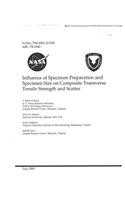
Influence of Specimen Preparation and Specimen Size on Composite Transverse Tensile Strength and Scatter
Series:
The influence of specimen polishing, configuration, and size on the transverse tension strength of two glass-epoxy materials, and one carbon-epoxy material, loaded in three and four point bending was evaluated. Polishing machined edges, arid/or tension side failure surfaces, was detrimental to specimen strength characterization instead of yielding a higher, more accurate, strength as a result of r
NaN
VOLUME
English
Paperback

The influence of specimen polishing, configuration, and size on the transverse tension strength of two glass-epoxy materials, and one carbon-epoxy material, loaded in three and four point bending was evaluated. Polishing machined edges, arid/or tension side failure surfaces, was detrimental to specimen strength characterization instead of yielding a higher, more accurate, strength as a result of removing inherent manufacture and handling flaws. Transverse tension strength was typically lower for longer span lengths due to the classical weakest link effect. However, strength was less sensitive to volume changes achieved by increasing specimen width. The Weibull scaling law typically over-predicted changes in transverse tension strengths in three point bend tests and under-predicted changes in transverse tension strengths in four point bend tests. Furthermore, the Weibull slope varied with specimen configuration, volume, and sample size. Hence, this scaling law was not adequate for predicting transverse tension strength of heterogeneous, fiber-reinforced, polymer matrix composites.OBrien, T. Kevin and Chawan, Arun D. and DeMarco, Kevin and Paris, IsabelleLangley Research CenterEPOXY MATRIX COMPOSITES; TENSILE STRENGTH; CRACKING (FRACTURING); GLASS; BEND TESTS; WEIBULL DENSITY FUNCTIONS; POLISHING...
Price Comparison [India]
In This Series
Bestseller Manga
Trending NEWS




















